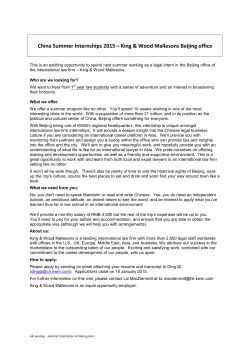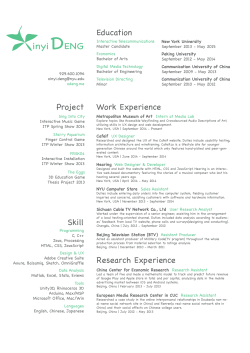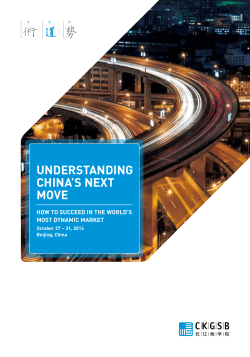
China`s New Silk Road - The National Bureau of Asian Research
c o m m e n ta r y China’s New Silk Road BY NAD ÈG E R O LL AN D Published: Februar y 12, 2015 The “China dream” of the “great rejuvenation of the nation” has been the hallmark of Xi Jinping’s presidency since he became party chief in late 2012. President Xi’s main idea is to restore China’s pre–nineteenth century grandeur and influence in order to make it a “prosperous, strong, culturally advanced and harmonious country.” The proposed revival of a great trade route that two thousand years ago bridged Eastern and Western cultures across the Eurasian continent might well help realize that objective. The idea of a new “Silk Road economic belt,” launched by President Xi during his tour of the Central Asian republics in October 2013, will mainly take shape along railway lines connecting several cities in western China to Europe via Central Asia, Iran, Turkey, the Balkans, and the Caucasus across the 11,000-kilometerlong Eurasian continent. The Chinese authorities see this transportation infrastructure as a first step toward the creation of a Eurasian “economic corridor,” allowing for the development of the landlocked Central Asian economies and their future integration with both European and Asian markets. They hope that trade liberalization and strengthened monetary cooperation among the economies connected by the railroad network will lead ultimately to a new form of regional economic community and—in the words of President Xi—give rise to “a sense of common destiny” among China’s neighbors. The new Silk Road will also branch out across Southeast Asia and have a maritime component extending across the Indian Ocean to the Persian Gulf and the Mediterranean. In all, the Chinese vision of a Silk Road economic belt (also dubbed “one belt, one road” by Chinese writers) encompasses a population of 4.4 billion people with a collective GDP of $2.1 trillion (one-third of the world’s wealth) and links emerging markets with strong growth potential. China already has close connections with the countries along this route thanks to existing trade and economic cooperation, but it hopes to strengthen transportation infrastructure and create new regional hubs and clusters of massive industrial parks. The infrastructure network envisioned by China will eventually link that country with three continents, with railroads, pipelines, and roadways reviving trade over land as well as along shipping routes. If this vision can be fulfilled, then eventually all roads will quite literally lead to Beijing. NADÈGE ROLLAND is the Senior Project Director for Political and Security Affairs at the National Bureau of Asian Research (NBR). Prior to joining NBR, Ms. Rolland served as senior adviser to the French Ministry of Defense and was responsible for analyzing diplomatic, military, and domestic political developments across the region. NBR Commentary • February 12, 2015 To the 21st-century global citizen, transcontinental and Eastern European countries meant to further railroad construction might seem passé, remote enhance cooperation, which includes plans to construct from the cyber age and reminiscent instead of the “a new corridor of interconnectivity.”2 Contracts and trans-Siberian or trans-American railway projects of subsidies for China’s national railcar manufacturer the mid-19th century. And yet the rapid expansion will strengthen its position in relation to foreign of railroads remains an important impetus for competitors and give it an advantage in overseas change. The railroad lines built across American markets. Beijing will provide financial aid to countries territory during the Gilded Age transformed a rural crossed by its railroads and develop their transport and country into a powerful industrial nation. Trains communications infrastructures, in many cases taking and railways converted a patchwork of disparate wild repayment in the form of local resources. territories into a unified country. As transportation Domestic security considerations also provide an costs dropped, new manufactured impetus for building a regional products flooded into remote areas, transportation infrastructure. In “For China, the proposed new opportunities for exploitation of 2000, then secretary general Hu natural resources were created, Silk Road is, among other goals, Jintao decided that the Xinjiang numerous technical innovations a tool for promoting national Uyghur Autonomous Region—a were born, and modern management region regularly rocked by methods developed. It is possible that economic development by ethnic violence and affected by a similar development pattern could boosting exports, enhancing the religious radicalization of occur in China’s backyard as the new part of its population—had to Silk Road economic belt is brought access to natural resources, and be more closely tied to the rest to completion. As was true 150 providing support to important of the country. This decision years ago, greater transcontinental was followed by the launch of interconnectivity via rail could domestic industries.” an extensive program to build boost trade, stimulate technological rail and road infrastructure development, and transform the connecting the remote and strategic landscape. impoverished region with the For China, the proposed new Silk Road is, among other goals, a tool for promoting national economic development by boosting exports, enhancing access to natural resources, and providing support to important domestic industries. The Chinese government has recently reportedly committed to devote as much as $1 trillion to infrastructure investments, including in the central and western provinces, which are bound to become the gateway to the Silk Road.1 Furthermore, Premier Li Keqiang embarked on an international “railway diplomacy tour” throughout 2014 and, as recently as in December 2014, announced the creation of a $3 billion investment fund for Central 1 more dynamic regions of eastern China. Beijing firmly believes that the political and ethnic tensions in Xinjiang can be attenuated by economic development and for this reason has been investing massively in the local economy and infrastructure. Fifteen years on, a similar logic is now being applied to China’s “near abroad.” Beijing aims to build railways that will connect the Xinjiang region to its Kazakh and Kyrgyz neighbors, and then westward to the Middle East and Europe, in the hope that economic development brought by building infrastructure will enhance the political stability in these areas. “China Said to Accelerate $1 Trillion in Projects to Spur GDP,” Bloomberg, January 5, 2015, http://www.bloomberg.com/news/articles/2015-01-05/chinasaid-to-accelerate-1-trillion-in-projects-to-spur-growth. 2 2 “China Looks to Europe—Through the Balkans,” Financial Times, beyondbrics, December 19, 2014, http://blogs.ft.com/beyond-brics/2014/12/19/china-looksto-europe-through-the-balkans. NBR Commentary • February 12, 2015 China’s “infrastructure diplomacy” also reflects a The proposed Silk Road economic belt aims to diplomatic imperative to strengthen relations along integrate China’s neighbors more closely with the the country’s continental periphery at a time when Chinese economy, enmeshing them in a network territorial disputes have strained relations with of trade ties, transportation links, and multilateral maritime neighbors. Developing good relations with regional institutions that will have China at their center, neighbors is again at the heart of China’s diplomacy enhancing Beijing’s influence over the weaker, poorer since President Xi made it a priority at a conference nations that surround it. The Asian Infrastructure in October 2013. Given the deterioration of relations Investment Bank launched last October in Beijing is on its eastern maritime flank, China now wants to one such mechanism and will assist in funding some build relations of cooperation and of the projects that will be a part of stability on its western land flank. the new Silk Road. “China’s ‘infrastructure The U.S. footprint there is not as Finally, the infrastructure strong as in maritime East Asia, diplomacy’ also reflects a diplomacy initiated by Beijing also has where Washington is pursuing diplomatic imperative to a critical strategic motivation. For over a policy of “rebalancing” that a decade, Chinese authorities have relies heavily on its traditional strengthen relations along the sought to circumvent the “Malacca allies (mostly maritime powers, country’s continental periphery dilemma” by finding ways to lessen such as Japan, South Korea, reliance on the Southeast Asian strait the Philippines, Thailand, and at a time when territorial disputes through which 80% of China’s energy Australia) while seeking to have strained relations with supplies from the Middle East and develop new partnerships with West Africa now pass. The planned maritime neighbors.” infrastructure, including pipelines Southeast Asian countries such as Vietnam and Myanmar. As and roads as well as railway lines, will the United States reduces its improve China’s ability to transport presence in Afghanistan, China crucial energy resources from suppliers in Central Asia is contemplating economic involvement equivalent and the Middle East. The fear of a maritime blockade to what it has achieved in Central Asia for more than imposed by the United States in the event of a conflict a decade, including the construction and upgrading in East Asia (one option proposed by critics of the of pipelines and mineral extraction infrastructure, air-sea battle concept) has led Chinese thinkers to transport facilities, and communications. Beijing look for ways to bypass sea lanes subject to U.S. naval hopes to keep its backyard as stable as possible and dominance. In this sense, the new Silk Road vision to continue to rely on the stability of Central Asian offers a sort of homecoming for China, which has secular autocracies, rich in oil and gas, to secure part of historically given priority to its landmass at the expense China’s energy supplies and prevent the radicalization of maritime expansion. of its own Muslim population. As it focuses more The new Silk Road advocated by Beijing is more clearly on Central Asia, China is bound to encounter than just a rail network expanding its grid across Russia’s presence and influence. But instead of creating the Eurasian continent but instead opens an array friction, the proposed new Silk Road is intended to of new economic and strategic possibilities. Chinese create more cooperation between Beijing and Moscow, authorities hope that it will lead eventually to a even more so as relations between Russia and Europe situation in which Europe becomes a mere peninsula at have grown increasingly strained, leaving President the end of the Asian continent, economically integrated Vladimir Putin without many options for support with and dependent on the Chinese locomotive, while and partners. the United States is relegated to the position of a distant 3 NBR Commentary • February 12, 2015 island, floating between the Atlantic and the Pacific. The birth of a transcontinental economic corridor, as envisioned by the Chinese authorities, could change the global landscape, shifting the focus of strategy and commerce to the Eurasian landmass from the waters surrounding it and reducing the significance of U.S. naval supremacy. This corridor could further intensify intra-European divergences over Asia policy, cause deep differences between the United States and its European allies, and sharpen commercial rivalries. If Europe turns increasingly to Asia instead of looking across the Atlantic, and if China succeeds in linking itself more closely to Russia, Central Asia, Eastern Europe, and the Middle East, then U.S. policymakers may be compelled to radically alter their traditional approaches to these regions and indeed the entire world. • THE NATIONAL BUREAU OF ASIAN RESEARCH (NBR) is a nonprofit, nonpartisan research institution headquartered in Seattle, Washington, with a second office in Washington, D.C. For information on NBR’s programs, please visit www.nbr.org. Media inquiries may be directed to Rachel Wagley at media@nbr.org or (202) 347-9767. Join the NBR community: Facebook.com/NBRnews Twitter: @NBRnews the national bureau 1414 ne 42nd street, suite 300 seattle, wa 98105 • 206-632-7370 of asian research 1301 pennsylvania avenue nw, suite 305 washington, d.c. 20004 • 202-347-9767 www.nbr.org @nbrnews
© Copyright 2025









